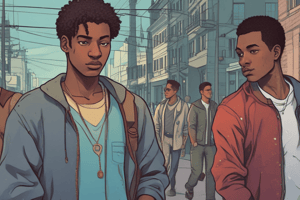Podcast
Questions and Answers
What is meant by 'the invention of adolescence,' and how might this concept influence our approaches to addressing youth crime?
What is meant by 'the invention of adolescence,' and how might this concept influence our approaches to addressing youth crime?
The invention of adolescence refers to the social construction of adolescence as a distinct life stage. This can influence approaches by shaping perceptions of youth as either vulnerable and in need of support or as inherently problematic and requiring control.
Explain the difference between 'fear of youth' and 'fear for youth,' and provide an example of how each might manifest in youth justice policies.
Explain the difference between 'fear of youth' and 'fear for youth,' and provide an example of how each might manifest in youth justice policies.
'Fear of youth' involves anxiety about the perceived threat posed by young people to society, leading to punitive measures. 'Fear for youth' involves concern for the well-being and safety of young people, leading to protective and rehabilitative measures.
How do self-report surveys differ from official crime statistics, and what are the implications of these differences for understanding youth crime?
How do self-report surveys differ from official crime statistics, and what are the implications of these differences for understanding youth crime?
Self-report surveys gather data directly from individuals about their own criminal behavior, while official crime statistics are based on reported incidents and arrests. Self-report surveys can reveal hidden or unreported crime. Official statistics only reflect reported crime.
According to drift theory, how do young people rationalize their involvement in criminal behavior?
According to drift theory, how do young people rationalize their involvement in criminal behavior?
What are some potential negative consequences of labeling a young person as a 'gang member,' even if they are only loosely associated with a gang?
What are some potential negative consequences of labeling a young person as a 'gang member,' even if they are only loosely associated with a gang?
Why might diversion programs be considered a beneficial approach to youth justice?
Why might diversion programs be considered a beneficial approach to youth justice?
In the context of youth crime, what are 'moral panics,' and how can they impact public perception and policy?
In the context of youth crime, what are 'moral panics,' and how can they impact public perception and policy?
What is the Crime Severity Index (CSI), and how does it differ from the crime rate in measuring crime trends?
What is the Crime Severity Index (CSI), and how does it differ from the crime rate in measuring crime trends?
What is the 'biggest cure' for youth offending, and what does this imply for intervention strategies?
What is the 'biggest cure' for youth offending, and what does this imply for intervention strategies?
What factors might explain the provincial variations in how the Youth Criminal Justice Act (YCJA) is applied across Canada?
What factors might explain the provincial variations in how the Youth Criminal Justice Act (YCJA) is applied across Canada?
Flashcards
Diversion in Youth Justice
Diversion in Youth Justice
This refers to the separation of youth offenders from adult offenders in order to shield them from the harsh realities of the adult system.
Intervention in Youth Justice
Intervention in Youth Justice
This refers to intervening in the lives of young people to facilitate positive change and prevent future offending.
Aging Out of Crime
Aging Out of Crime
This is the idea that young people tend to reduce their involvement in criminal activity as they get older.
Recidivism in Youth Crime
Recidivism in Youth Crime
Signup and view all the flashcards
Moral Panic
Moral Panic
Signup and view all the flashcards
Moral Entrepreneurs
Moral Entrepreneurs
Signup and view all the flashcards
Drift Theory
Drift Theory
Signup and view all the flashcards
Labelling Theory
Labelling Theory
Signup and view all the flashcards
Youth Criminal Justice Act (YCJA)
Youth Criminal Justice Act (YCJA)
Signup and view all the flashcards
Study Notes
Week 3: Introduction - Syllabus
- The midterm will have short answer and essay questions with choices
- Make time to meet with the TA
- Class will run from 10 AM to 12 PM
Youth Justice and Crime
- Youth offenders can be clever when committing crimes, especially serious ones
- PC Styles' death was caused by a 15-year-old driving his parents' car, who accelerated when pulled over and killed Styles
- Youth crime differs from youth justice in the community, how it is apprehended, and its causes
- The most important challenge is understanding the causes of youth crime
- Questions to consider include defining "the invention of adolescence," the impact of youth depictions, and the goals of the youth justice system
- Other questions include the need for a separate system, diversion, intervention, rising violence among young people, and why some end up on the streets
- Issues in defining gang involvement include distinguishing hanging out from gang association
- Considerations include how to balance fear of youth with fear for youth
- The Youth Criminal Justice Act was enacted in 2001
Studying Crime
- Official statistics offer an objectivist/legalistic perspective
- Official statistics narrow focus, give a picture, and provide characteristics (UCR2)
- The Crime Severity Index (CSI) is standardized to a base of 100 in 2006, allowing comparisons across time and space
Notes on Statistics
- Explaining statistics to someone else, understanding what stats capture, and acknowledging limitations are key
- Juristat can be useful for research papers and other assignments
Media and Crime
- Drift theory suggests youth learn deviant justifications for criminality
- The biggest "cure" is for young offenders to grow out of crime
- Young people are more likely to commit deviant acts when unsupervised, with school being the safest environment
- Youth are more likely to offend in groups, but that does not always mean it is gang-related
- Provincial jurisdictions have variation of Youth Criminal Justice
- Recidivism suggests young people are likely to continue to offend, if they already offend
- There are no differences between first-time offenders and recidivists
- First time offenders tend to commit minor crimes like assault level 1, theft under $5000, possession of stolen property and mischief to property
- Self-report surveys differ from official metrics and focus on enforcers rather than offenders
- Youth are more likely to be victimized and engage in crimes
Police-Reported Youth Crime (2019-2020)
- Most youth crime is non-serious property crime
- Violent crime accounted for 46% of cases in 2020 and 42% in 2019
- The majority of violent crimes is non-serious level 1
- 71% of all assaults and 97% of sexual assaults are non-serious level 1, more serious assaults involve a weapon
- Homicides involve small numbers with n = 45, or 0.083% of cases
Crime Rates among Young People
- Assault Level 1/Mischief is the leading cause of youth coming before courts
- Administration of Justice Violations are also common
- Homicide and attempted murder are the least common serious crimes
Things of Note
- The aging-out effect of crime, geographical variation such as sentences to custody in PEI and the Yukon, and recidivism
- First time offenders are not likely to be serious offenders
- Schools are safe places however after school is not
- Offending often occurs in groups
Moral Panics and Social Reactions
- Societal anxiety, a moral panic is more specific than generalized anxiety related to racial anxiety or welfare state collapse etc
- Threats are labeled and depicted in stylized/stereotyped ways, like mugging or swarming
- Stanley Cohen is known for talking about moral panic, moral entrepreneurs can diagnose issues whereas experts can determine solutions
- Moral panic is more about the fear of crime or of young people
- The following link contains information about wilding: http://video.phs.org/video/236332776
Concerns with Moral Panic Literature
- Media and the public aren't homogenous
- There is no concerted effort as populace just needs better information
- Emotional aspects are important
- Moral panic is applied to successful interventions
- An example of failed moral panic includes concerns about ecstasy use / young people going to raves during their leisure time
- Moral panic helps to frame problems, identify narratives, and determine who gets othered
Social Reaction Research Topics
- Mods and rockers, as researched by Cohen
- Sub-culture theory considers deviance as a collective rather than an individual response.
- A.K. Cohen argued that subcultural deviance results from status frustration and is a non-utilitarian form
- Gender issues, such as the murder of Reena Virk in BC may relate to moral panic, race, the war on drugs and youth offenders
Punishable Youth Offender? (Hogeveen Ch. 8)
- This topic explores if young people were punished more due to the YCJA
- Hansard (Debates) are transcripts of chamber proceedings named after the Hansard family, who printed Britain’s parliamentary debates from 1812 to 1892
Annotated Bibliography
- Students should write a short paragraph introducing their literature review/final paper topic Five peer-reviewed articles should be summarized explaining their relevance, and contributions to the paper, and avoiding book chapters in the research
Studying That Suits You
Use AI to generate personalized quizzes and flashcards to suit your learning preferences.




